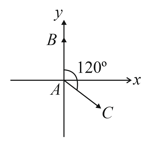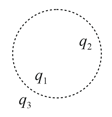A uniformly charged conducting sphere of in diameter has a surface charge density of . Calculate the
(i) Charge on the sphere.
(ii) Total electric flux coming out a Gaussian surface just enclosing the outer surface of the sphere.

Important Questions on Electric Charges and Fields
(a) What is the surface charge density on the
(i) Inner surface?
(ii) Outer surface of the shell?
(b) Derive the expression for the electric field at a point from the centre of the shell.
Two small identical electric dipoles and , each of dipole moment are kept at an angle of as shown in figure. What is the resultant dipole moment of this combination? If this system is subjected to electric field directed along direction, what will be the magnitude and direction of torque acting on this?

(ii) Two positive point charges which are apart repel each other with a force of . If the sum of the charges be , calculate their separate values of charges.
(ii) Two point charges and are located at and . Find and using vector form of Coulomb's law.
(ii) A particle of mass and charge is thrown at a speed against a uniform electric field . How much distance will it travel before coming to rest?
(ii) Four identical point charges of each are placed at the corners of a square of each side . Calculate the electric field at the centre of the square.
(iii) Calculate the electric field intensity at the centre, when one of the corner charges is removed.
(i) Two charges of a dipole and are placed at the points and located in an electric field . Calculate the torque acting on the dipole.
(ii) A Gaussian surface is shown in figure. Charges and are inside and charge is outside the surface. Indicate the charges which contributes the electric field appearing in the formula .

(iii) The electric field in a region is given by with Find the flux of this field through a rectangular surface of area parallel to plane.
